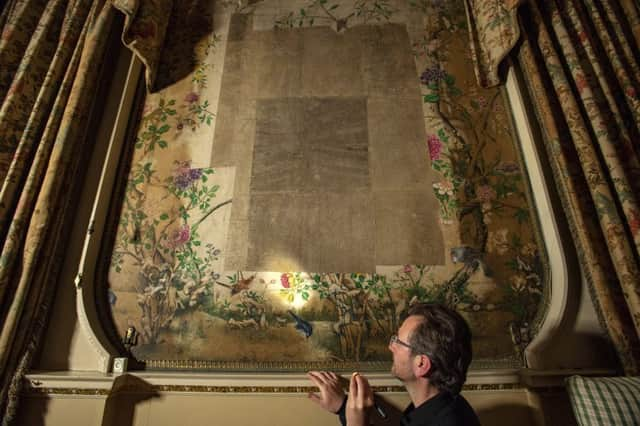Restoration of a masterpiece reveals Chippendale papered around the edges


The 12ft mirror he installed to fill the wall space between the windows of the state apartment at Wakefield’s Nostell Priory has for 250 years reflected the opulent, gilded decorations around it. But its removal for probably the first time since the 19th century has revealed a Georgian trick of the trade: Chippendale had papered around the edges.
The large mirror, known as a pier glass, had been installed for Sir Roland Winn, one of Chippendale’s premier local clients. Winn’s family built and owned the Palladian mansion at Nostell until it was handed to the National Trust in the 1950s.
Advertisement
Hide AdAdvertisement
Hide AdThe opportunity to see behind the looking-glass as conservation work was carried out on its reflective surface and elaborately carved frame, had shed new light on its creator’s technique of sparing the expensive, hand-painted Chinese wallpaper where it was not going to be seen.
The project curator, Simon McCormack, said he had suspected Chippendale might have skimped even more dramatically. “The wallpaper was extraordinarily expensive. It was painted by Chinese craftsmen and exported by agents of the East India Company,” he said.
“We knew that Chippendale bought 18 sheets of it and that Ronald Winn, who was a bit of a skinflint, haggled him down.
“So we had expected just a lip of an inch of paper around the mirror. In fact, there is six or eight inches before it runs out.”
Advertisement
Hide AdAdvertisement
Hide AdThe restoration has also revealed Chippendale’s original markings on the back of the mirror – itself an extravagance for its time, since the production of mirrored glass was still prohibitively expensive – and betrays the original, vibrant colours of the Chinese wallpaper.
“The sky is a pale white, not the tobacco colour it had taken on from exposure to the light and to coal dust from the Victorian era,” Mr McCormack said.
The paper, which came in 10ft sheets, would have been ordered by Winn to show off, he added.
“House owners in the 18th century wanted to be able to show a country that Europeans had no access to. China was closed to foreigners at the time.”
Advertisement
Hide AdAdvertisement
Hide AdThe pier glass, meanwhile, was provided not for occupants of the state apartment to admire themselves in, but to increase the available light in the room by reflecting it.
“Lighting was expensive, if you had to use wax candles,” Mr McCormack said.
John Hartley, whose firm is carrying out the conservation work, said Nostell had probably the best documented collection of Chippendale furniture.
“The ornate frame was carved by hand and there’s plenty of evidence of the people that crafted it,” he said.
“When we carefully dismantled the frame, we uncovered the outline drawings of carvings underneath, most likely as a guide to the glazier.”